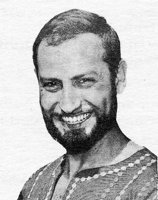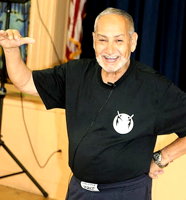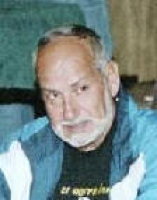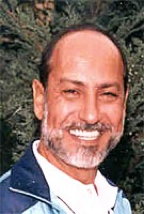|
Moshiko Halevy
|
|
CLICK AN IMAGE FOR LARGER VIEW
 Moshe "Moshiko" Itzchak-Halevy is the son of an old Yemenite family. He was born in 1932 in Jaffa, Israel (then Palestine) in the Menashiya district near the Yemenite Quarter. His first introduction to the world of dance was in 1949, through the study of classical ballet, character, modern, and jazz dance at the studio of Mia Arbatoba (for five years).
Moshe "Moshiko" Itzchak-Halevy is the son of an old Yemenite family. He was born in 1932 in Jaffa, Israel (then Palestine) in the Menashiya district near the Yemenite Quarter. His first introduction to the world of dance was in 1949, through the study of classical ballet, character, modern, and jazz dance at the studio of Mia Arbatoba (for five years).
Moshiko did his military service within the framework of a military entertainment troupe, and upon termination of his service, was invited to appear in a number of musical programs as lead dancer. In addition, he devoted much of his time to the study of modern ballet and jazz.
In 1954, Moshiko joined the Yemenite Dance Theatre Inbal, where he became reacquainted with his origins by working for six years as one of their principal dancers. While participating in Inbal's two successful world tours, Moshiko fell in love with mid-eastern folklore and began to try his hand at the choreographing of folk dances.
 In 1959, Moshiko created his first dances, Debka Uriah (known in America as Debka Habir), Debka Cana'an, and Et Dodim Kala. These dances expressed his strong personality and also paved the way for his acceptance among the acclaimed choreographers of Israeli dance. He has since created many more, thus establisning himself as one of Israel's most famed and exciting folk dance choreographers.
In 1959, Moshiko created his first dances, Debka Uriah (known in America as Debka Habir), Debka Cana'an, and Et Dodim Kala. These dances expressed his strong personality and also paved the way for his acceptance among the acclaimed choreographers of Israeli dance. He has since created many more, thus establisning himself as one of Israel's most famed and exciting folk dance choreographers.
Moshiko left Inbal in 1960 and founded his own group, Hapa'amonim (in Hebrew, "The Bells"), an Israeli group dedicated to folklore, dance, and song. For eight years he headed the group as choreographer and the group met with great success in Israel and was invited to appear in Europe. There, too, the group was very successful and enthusiastically received. In spite of being very busy with his own company, Moshiko did not neglect his ties with Israeli folk dance and continued to create dances such as Debka Kurdit, Ein Adir, Hamecholet, Tfilat Hasachar, and Ha Helech, in which he shows an individual, creative style of his own.
The Cultural Department of Arabs at The Worker's Federation in 1966 appointed Moshiko as instructor and artistic advisor in Israel for minority groups, such as the Arabs, Cerkissians, and Druze. Moshiko terminated his activities with Hapa'amomim in 1968 and has since dedicated himself to teaching choreography and working with minority groups. Also in 1968, Moshiko was invited to teach dances for three months under the auspices of NEVO, the folk dance society of Holland. He was invited to bring three groups from Israel with him -- Circissian, Druze, and Yemenite -- so they could participate in both the Folklore Festival, held in Leyden, Holland, and the festival held in Scooten, Belgium.
 In 1971, Moshiko was invited to be the Inbal Dance Theater company manager. Then, in 1973, he led the troup on their successful United States tour.
In 1971, Moshiko was invited to be the Inbal Dance Theater company manager. Then, in 1973, he led the troup on their successful United States tour.
Moshiko is influenced in his dance creations by his work with minority groups. This influence is clearly seen in his famous Debka dances. These dances are based on Oriental / Arabic motifs. There is no doubt, whatsoever, that Moshiko is a choreographer who has introduced a different spirit into Israeli dance style and has made a recognizable contribution to the fields of folk dance and folklore.
In 2003, Moshiko was elected president of the Irgun Hamadrichim. The Irgun, as it is commonly referred to, is a professional organization in Israel that represents Israeli Folkdance teachers in all aspects, including acting as a union representing teachers as employees, negotiating between teachers themselves, establishing a chart ranking teachers and determining salary based on rank and age, determining price per harkada (Israeli dance event), conducting new dance hishtalmiot (workshops), and monitoring ethical behavior between teachers.
Moshiko has produced several recordings on his own MIH label.
Dances Moshiko has taught include Abaya (Et Kashet Li Be'abaya), Abdabak, Ahava Zmanit, Al Lanu, Al Levavi, Al Yadil, Aley Givah, Alizut, Alumim, Amok Balev (Ahibak), Ana Lach, Ani Zoher, Ariel, Asal, Ashira La'Ha'Shem, Ashuri, At Kmo Shir, Atari, Avaya, Avi Avi, Avney Hahoshen, Ayuma, Ba'ayara, Balkan, Bachura Yafa, Bamishol, Bashvilim, Bat Teiman, Beklilut, Belev Haleil, Belev Sameach, Ben Ya, Bereshit, Betof Utzlil, Betzet Chatan, Bikilut, Bosmat, Bracha, Buki Dalale, Cha Cha Mo, Chalomot, Chirbim, Cholot Lohatim, Da'asa, Dalit, Debka Abaya, Debka Adi, Debka Bedouit (Debka Beduit), Debka Cana'an, Debka Dor, Debka Kna'an, Debka Kurdit, Debka Uriya (Debka Uriah, Debka Habir), Debkat Adi, Dilam Bazan, Diwan, Dmaot Ahava, Dror Yikra II, Eimi Yoladeti, En Adir, El Ha'ayin, Elay, Elef Layla, En Adir, Eretz Ahuva, Eshal Elohay, Eshet Chayil, Et Ashir, Et Dodim Kala, Et Gar, Et Kashet Li Be'abaya, Etgar, Fusae Ko, Ga'aguim, Galey Hamizrach, Gami Li Ei, Gamla, Gam Li El, Geulim Ha'emek Hu Chalom, Haduni, Hageula, Hahelech, Haidel Haidel, Haleluya, Halevay Alay, Halo, Mahangina Sheli, Hamavdil, Hamecholelet, Hanagun, Har Hatsofim (Meal Pisgat Har Hatsofim), Hareshut, Hashofar, Hayiti Rotze, Hechalil, Hey Yo Ya, Hitahavti Bezemer (Yo M'namori D'un Aire), Hodu Lashem, Hora Chemed, Hora Esh, Hora Li, Hora Shemesh, Hora Yamit, Israpiko, Jeti Li, Ke'ev Rosh, Karen Shachar, Ki Hivshilu Eshkolot, Kineret, Kiria Yefeifya, Kissufim, Kochav Haruach, Kol Od, Kurdi Nash, Lach, Lechabek Otach, Lefelach Harimon, Leilot Knaan, Lema'ana, Libi, Lo Eten Lach, Lo Sharti Lach Artzi, Lu Hayit Hana'ara, Ma Tov, Machol Gruzini, Marhaba, Masoret, Mavani, Mechol Hadvash (Dvash), Mechol Hamezeg (Shir Hamezeg), Mechol Hashnayim, Mi Kamocha, Mishaela, Mish'al (Debka Mishal), Mizmor Shir, Mizrach Ma'arav, Mor, Moshi Tanas, Moti, Neima Tajikit, Nerot Shabat, Netafim, Nijad, Nina, Nishmat Kol Chay, Nofim, Odeh Ya, Odeni Yalda, Omer, Oneg Shabbat (Shir Shabat), Oy Yossel Yossel, Pa'am Haiynu, Perach Zahav, Pgisha Mikrit, Rava Dolta, Rei'ach Hadas, Reichan, Renanim, Sachki Sachki, Saharane, Saraleh, S'ee Yonah (Se'i Yona), Sha'a Le'ahava, Shababe, Shabbat Malka, Shai Le'ala (Shai L'ella), Shatiach Parsi, Sherine, Shevach La'el, Shir La'emek, Shir Preyda, Shirat Hayam, Shma Ha'el, Shma Israel, Shovevut, Shuvi Hashulamit, Shuvi Shuvi, Sirta Moswh (Binti Nas), Smadar, Sodot Midbar, Tama Temima, Targil Teimani, Tcherkes, Tel Giborim, Tfilat Haderech, Tfilat Hashachar, Tinten Banat, Tsachki Tsachki (Sachki Sachki), Tsame, Tsur Eli, Tza'ada, Tzanah (Sana), Tzur Mishelo, Ulu, Ura Israel, Uri Tzafon, Uvayom Hashabbat, Vals Avivi, Vals Hanigun, Vals Hashashanim, Vals La'ohavim, Vals Latikva, Vehashem Mitzioin Yishag, Vesamachta Bechagecha, Veshavu Banim, Ya Abud (Debka Abud), Ya Habib (Debka Ya Habib), Ya Halali Ya Mali, Yaffo (Debka Yaffo), Yakir Menachem, Yam Hatchelet, Yam Tichon, Yanuka, Yelialt Haru'ach, Yellow River, Yenuka, Yesh Li Gan, Yimloch Hashem, Yiska, Yom Ezkera, Ylelat Haruhach, Yumati, Yuvali Ninati, Zafeh (Ayelet Chen), Zakariya (Debka Zakariya), and Zer Shirim.
